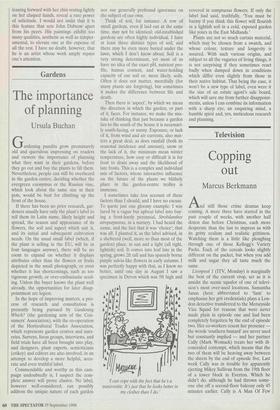Exhibitions 2
John Dubrow (Salander-O'Reilly Galleries, New York, till 26 September)
Animating warmth
Roger Kimball
In the second act of The Tempest, when the King's shipwrecked party awakes to find itself on Prospero's island, there is a memorable exchange between the cheerful old counsellor Gonzalo and the rascals Sebastian and Antonio:
Gonzalo: How lush and lusty the grass looks! How green!
Antonio: The ground indeed is tawny. Sebastian: With an eye of green in't.
Antonio: He misses not much.
Sebastian: No; he doth but mistake the truth totally.
Among other things, this vignette suggests that the island appears differently to differ- ent people: lush and welcoming to the mild Gonzalo, desiccated and unwelcoming to his unpleasant companions.
I thought of this passage when looking at John Dubrow's panoramic views of Man- hattan, a handful of which, along with a half-dozen other pictures by the artist, are on view at Salander-O'Reilly. Painted from temporary studios on the 85th and 91st sto- ries of the World Trade Center, these pic- tures present the crowded metropolis bathed in a beneficent light.
The 40-year-old Dubrow has managed to impart an unusual spaciousness and ampli- tude to these cityscapes. Seen from his eyries at the southern tip of the island, Manhattan vibrates with a cheerfulness most of us would associate more with San Francisco, where Dubrow studied, than New York. Despite their almost aerial per- spective his cityscapes do not so much look down upon as forward to their subject. In a view looking north, the uncluttered band of sky at the horizon helps to open up the pic- ture, while patches of green and russet in the foreground humanise or 'naturalise' the packed intensity of the urban scene. The warm, southwesterly light in which Dubrow has swathed the city infuses the picture with a solicitous clarity and repose. This is quite recognisably Manhattan — the Empire State Building, for example, rises up, a familiar beacon, anchoring the reticu- lated quilt of architecture that is unfolded before it — but it is Manhattan made hab- itable, almost peaceful, by generous eyes.
Dubrow communicates a very different feeling in a view looking south over the harbour and, glittering in the right middle distance, the Statue of Liberty. In the fore- ground, two clutches of buildings stand divided by the grey strip of an almost deserted thoroughfare that terminates at Manhattan's tip. The early light and sharp- er shadows impart an almost Hopperesque aura to the picture, a sense of minor deso- lation only partly tempered by the radiant belt of sky at the top of the picture plane. This is a scene of suspended possibilities and lonely habitation; the only movement is the white trail of a ferry steaming home- ward across the green-grey-blue wash of the limitless bay. The poignancy of that gash of white lies in the distance and unreachableness of the human purposes it conveys.
Dubrow has a special aptitude for enlist- ing perspective to his aesthetic ends. He is particularly adroit at manipulating vast dis- tances without sacrificing the pulse of lived-in space. While his cityscapes with their lofty, bird's-eye views are perhaps his most distinctive pictures, the most ambi- tious work on view at Salander-O'Reilly is undoubtedly the huge, 7 by 14-ft depiction of Brooklyn's Prospect Park. In this pic- ture, the perspective is more or less eye- level. But here, too, a vanishing distance plays an critical role in organising the pic- ture's space and arranging the figures that populate the canvas in graduated zones of intimacy. 'Prospect Park', which Dubrow has laboured over on and off again for four years, is a remarkable painting. Its obvious compositional allusion to Seurat's 'Grande Jane' adds an element of art-historical sophistication to the rus in urbe theme of the painting. Dubrow's achievement here is twofold. He has managed to communicate a sense of absolute contemporaneity while maintaining a high level of visual decorous- ness. He has also managed to combine a vivid sense of local activity — especially among the several canine figures disporting themselves in the park — with the caesura of a tableau vivant.
The animating warmth in Dubrow's pic- tures shows itself in its most concentrated form in two recent portraits of a woman called Phippy. Notwithstanding the dehu- manisation presupposed by much contem- porary art, it is in treating the human figure, and especially the human face, that an artist reveals himself most conspicuous- ly. These portraits, particularly the small, fetching depiction of Phippy seated and T.K Reading, by John Dubrow, 1998 leaning forward with her chin resting lightly on her clasped hands, reveal a rare power of solicitude. I would not insist that it is this feature that sets John Dubrow apart from his peers. His paintings exhibit too many qualities, aesthetic as well as temper- amental, to elevate one at the expense of all the rest. I have no doubt, however, that he is an artist whose work amply repays one's attention.











































































 Previous page
Previous page